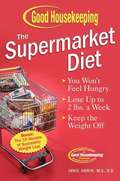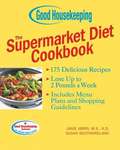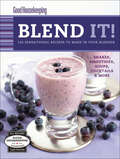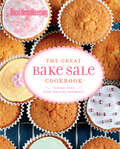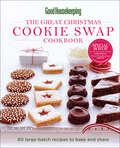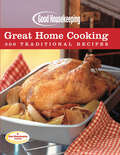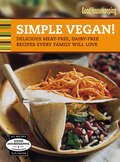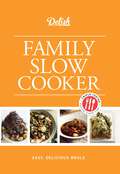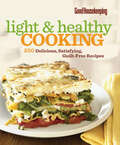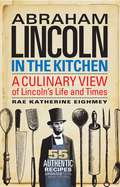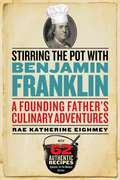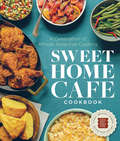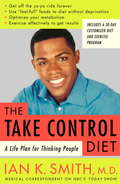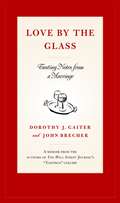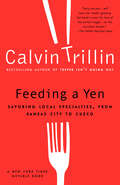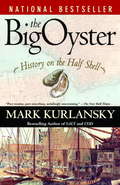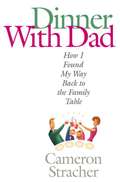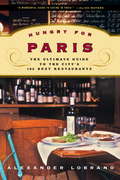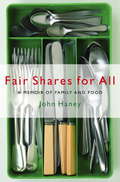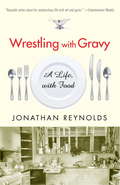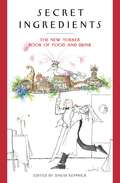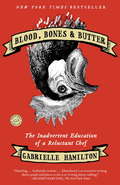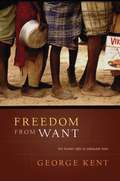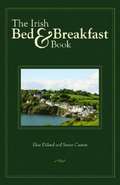- Table View
- List View
The Supermarket Diet
by Janis JibrinThe trusted diet and nutrition experts at Good Housekeeping present a slimming, easy new way to shop the supermarket aisles and reach your ideal weight. Buy the right packaged and convenience foods, add a delicious assortment of fresh produce, follow Good Housekeeping's recipes, and watch the pounds drop.
Good Housekeeping: The Supermarket Diet Cookbook
by Janis Jibrin Susan WestmorelandLet Good Housekeeping hold your hand, guiding you as you prepare tasty diet-friendly meals! Remember: people who eat at home tend to be thinner than those who eat out often. Even those who don't feel comfortable in the kitchen can easily make these recipes, which have all been triple-tested in the magazine's acclaimed kitchens. Most of the recipes take no more than 20 minutes from stove to table--less time than picking up calorie-laden take-out. And they're also nutritious, so they not only help you drop pounds, but also could lower the risks for heart disease, cancer, diabetes, and other ailments. But of course, vitamins and minerals don't lure dieters to the table: taste does, and these dishes are absolutely delicious. Meals such as Asparagus, Red Potato, and Romano Frittata; Salmon with Tomato-Oliver Relish; Steak and Pepper Tortillas, and Tortellini with Zucchini and Radicchio are as palate-pleasing as they are weight-reducing. And leave room for desserts like Apricot Soufflé and Seattle Cappuccino Angel Food Cake. Both veterans of the plan and newcomers will find this cookbook--which summarizes all the Supermarket Diet basics--invaluable!
Good Housekeeping: 150 Sensational Recipes to Make in Your Blender-Frappes, Smoothies, Soups, Pancakes, Frozen Cocktail (Good Housekeeping Mini Cookbook Series)
by Barbara ChernitzWith your blender and this book, you can create 150 amazing recipes for drinks, meals, meals that are drinks, and more.You may know that Good Housekeeping recipes are triple-tested, nutritious, and tasty, but these treats are also pure, delicious fun. Mouthwatering color photos and illustrations will tempt you to get started, and there’s plenty of helpful information on using the blender effectively. Try a classic Banana-Strawberry Smoothie for breakfast and whip up a Frosty Cappuccino that’s better than store-bought. Serve chilled Gazpacho with Cilantro Cream for a cool summer meal. Hummus, Chicken Pâté, or Roasted Eggplant Dip with Herbs make great appetizers or side dishes. Every recipe includes prep and cooking times, the number of servings, and key nutritional details.
Good Housekeeping: 75 Sure-Fire Fund-Raising Favorites
by Susan WestmorelandFrom the test kitchen of America&’s iconic lifestyle magazine, recipes and tips for organizing a successful bake sale fundraiser—includes photos. &“Mom—I need three dozen cupcakes for the school bake sale . . . tomorrow!&” Here&’s the book to grab when you hear those words. Good Housekeeping comes to the rescue with seventy-five tasty favorites for sure-fire fundraising success. From cupcakes to brownies, jumbo cookies to spiced nuts, these triple-tested recipes have been specially selected for this collection. You&’ll find long-time favorites and fresh new ideas—all easy to make and easy to portion and package for sale. An extensive introductory chapter covers the basics of bake sales—from organizing tips to creative ideas for packaging and display.
Good Housekeeping: 60 Large-Batch Recipes to Bake and Share
by Susan WestmorelandFrom the test kitchen of America&’s iconic lifestyle magazine, recipes and tips for participating in or hosting a holiday cookie exchange—includes photos. Butterscotch Fingers, Chocolate Crinkles, Gingerbread Cut-Outs, Peppermint Meringues: all these Christmas cookies sound delectable, but nobody can bake dozens of recipes at the same time. The solution? A swap! All across America, families, neighbors, community, and church groups gather at Christmas cookie swaps, where each participant brings a large batch of his or her favorite recipe to share. Everyone fills a plate or tin with samplings of the tasty treats; the more people, the merrier—and the more kinds of cookies to try. It&’s a fun way to enjoy a variety of Christmas tastes without doing all the work yourself—and to celebrate with those you love. Good Housekeeping helps home bakers enter into the joy, camaraderie, and pure deliciousness of this tradition with a new collection of 60 favorite Christmas cookie recipes from around the world—each configured to make batches of at least eight dozen cookies. Choose from holiday classics and contemporary twists; they&’re easy to make with everyday ingredients. And each recipe has been triple-tested for success in the famed Good Housekeeping Test Kitchen, so you can bake with confidence. For extra help, there are also great tips on techniques and shortcuts, as well as fun ideas for throwing the best cookie swap ever.
Good Housekeeping: 300 Traditional Recipes (Good Housekeeping Ser.)
by Beth AllenTaste America’s finest traditional dishes in this compilation of 300 sensational recipes.From Southern Fried Chicken to New England Clam Chowder, Good Housekeeping presents the best of traditional, time-tested American home cooking, all in one big, beautiful book. Every cook needs these favorites—with delectable photos and fascinating history tracing the recipes’ evolution—at her fingertips. All the recipes were triple-tested in the Good Housekeeping kitchens, where the magazine’s experts created the perfect rendition of each beloved dish. And what a delicious portrait of American cuisine they paint! Who could resist Maryland Crab dip, Bear Mountain Butternut Soup, Barbecued Pulled Pork, or Boston Cream Pie? The recipes also reflect the American “melting pot,” with dishes ranging from Egg Foo Yong to Huevos Rancheros. Plus—ever wonder how some of the most popular recipes were invented? Delightful historical sidebars provide background on the American culinary scene over time—Friday Night Fish Fries, Cakewalks at County Fairs, and more.
Simple Vegan!: Delicious Meat-Free, Dairy-Free Recipes Every Family Will Love (Good Housekeeping Cookbooks)
by Good HousekeepingFrom the test kitchen of America’s iconic lifestyle magazine, easy meatless, dairy-free recipes for family meals and entertaining—includes photos.Whether you're embracing a vegan lifestyle, adding a few vegan dishes to your meal plan, or cooking for a guest, this book is your road map to delicious vegan food! From Pumpkin Waffles to Polenta with Spicy Eggplant Sauce to Deep Chocolate Cupcakes (and even Mac and Cheese!), this tasty collection offers 100 irresistible recipes the whole family will love—all triple-tested by the Good Housekeeping test kitchen.
Delish Family Slow Cooker: Easy, Delicious Meals
by DelishWith this collection of sensational recipes, you can sit back and let your slow cooker do the work for you while you reap the delish benefits.Want a meal that tastes like perfection? That’s quick, easy, and affordable, too? Take it slowly! There’s nothing more mouthwatering, more filled with flavor, than food prepared in the slow cooker—and the culinary experts at Delish.com are here to show you how it’s done. From hearty soups and stews to delectable roasts, zesty curries, and to-die-for desserts, this appetizingly photographed cookbook presents fresh-from-the-farm ingredients and marvelously simple cooking techniques. It has all the basic slow-cooker information you need, from which settings to use to how much liquid to add to what cuts of meat work best. The luscious recipes include:Balsamic and Port Beef ShanksChicken with Leeks and ArtichokesRatatouilleBest-Ever Bolognese SauceFig and Cranberry Bread Pudding
Light & Healthy Cooking: 250 Delicious, Satisfying, Guilt-Free Recipes (Good Housekeeping Cookbooks)
by Good HousekeepingFrom the test kitchen of America’s iconic lifestyle magazine, “beautifully-photographed recipes . . . nutritionally sound meals . . . [and] delicious discoveries.”(Publishers Weekly)Great-tasting food and guilt-free eating pleasure: with this brand-new collection of 250 light, healthy, and delicious recipes from Good Housekeeping, you don't have to sacrifice flavor to eat right. From a scrumptious homey lasagna to a strawberry-rhubarb crisp you'll be proud to serve, all these dishes are family-friendly. Not only do the recipes incorporate healthful ingredients, and have thirty percent or fewer calories from fat, but many take less than a half-hour to complete. You'll even find slimmed-down versions of beloved comfort foods like burritos, burgers, pizza, pastas, and brownies. With invaluable tips on counting calories, understanding food labels, sensible shopping, and more, this cookbook makes eating well simple and satisfying.
Abraham Lincoln in the Kitchen: A Culinary View of Lincoln's Life and Times
by Rae Katherine EighmeyAbraham Lincoln in the Kitchen is a culinary biography unlike any before. The very assertion of the title--that Abraham Lincoln cooked--is fascinating and true. It's an insight into the everyday life of one of our nation's favorite and most esteemed presidents and a way to experience flavors and textures of the past. Eighmey solves riddles such as what type of barbecue could be served to thousands at political rallies when paper plates and napkins didn't exist, and what gingerbread recipe could have been Lincoln's childhood favorite when few families owned cookie cutters and he could carry the cookies in his pocket. Through Eighmey's eyes and culinary research and experiments--including sleuthing for Lincoln's grocery bills in Springfield ledgers and turning a backyard grill into a cast-iron stove--the foods that Lincoln enjoyed, cooked, or served are translated into modern recipes so that authentic meals and foods of 1820-1865 are possible for home cooks. Feel free to pull up a chair to Lincoln's table.
Stirring the Pot with Benjamin Franklin: A Founding Father's Culinary Adventures
by Rae Katherine EighmeyIn this remarkable work, Rae Katherine Eighmey presents Franklin's delight and experimentation with food throughout his life. At age sixteen, he began dabbling in vegetarianism. In his early twenties, citing the health benefits of water over alcohol, he convinced his printing-press colleagues to abandon their traditional breakfast of beer and bread for "water gruel," a kind of tasty porridge he enjoyed. Franklin is known for his scientific discoveries, including electricity and the lightning rod, and his curiosity and logical mind extended to the kitchen. He even conducted an electrical experiment to try to cook a turkey and installed a state-of-the-art oven for his beloved wife Deborah. Later in life, on his diplomatic missions--he lived fifteen years in England and nine in France--Franklin ate like a local. Eighmey discovers the meals served at his London home-away-from-home and analyzes his account books from Passy, France, for insights to his farm-to-fork diet there. Yet he also longed for American foods; Deborah, sent over favorites including cranberries, which amazed his London kitchen staff. He saw food as key to understanding the developing culture of the United States, penning essays presenting maize as the defining grain of America. Stirring the Pot with Benjamin Franklin conveys all of Franklin's culinary adventures, demonstrating that Franklin's love of food shaped not only his life but also the character of the young nation he helped build.
Sweet Home Café Cookbook: A Celebration of African American Cooking
by Jessica B. Harris Nmaahc Albert Lukas Jerome Grant Lonnie G. Bunch IIIA celebration of African American cooking with 109 recipes from the National Museum of African American History and Culture's Sweet Home CaféSince the 2016 opening of the National Museum of African American History and Culture, its Sweet Home Café has become a destination in its own right. Showcasing African American contributions to American cuisine, the café offers favorite dishes made with locally sourced ingredients, adding modern flavors and contemporary twists on classics. Now both readers and home cooks can partake of the café's bounty: drawing upon traditions of family and fellowship strengthened by shared meals, Sweet Home Café Cookbook celebrates African American cooking through recipes served by the café itself and dishes inspired by foods from African American culture.With 109 recipes, the sumptuous Sweet Home Café Cookbook takes readers on a deliciously unique journey. Presented here are the salads, sides, soups, snacks, sauces, main dishes, breads, and sweets that emerged in America as African, Caribbean, and European influences blended together. Featured recipes include Pea Tendril Salad, Fried Green Tomatoes, Hoppin' John, Sénégalaise Peanut Soup, Maryland Crab Cakes, Jamaican Grilled Jerk Chicken, Shrimp & Grits, Fried Chicken and Waffles, Pan Roasted Rainbow Trout, Hickory Smoked Pork Shoulder, Chow Chow, Banana Pudding, Chocolate Chess Pie, and many others. More than a collection of inviting recipes, this book illustrates the pivotal--and often overlooked--role that African Americans have played in creating and re-creating American foodways. Offering a deliciously new perspective on African American food and culinary culture, Sweet Home Café Cookbook is an absolute must-have.
The Take-Control Diet
by Ian K. SmithGET OFF THE DIETING ROLLER COASTER–NOW AND FOREVER! You already know that fad diets don’t work. But that doesn’t mean you can’t lose weight! Here at last is a science-based diet that will give you the body you want. The secret is to work with your body, not against it. Exploding the many diet myths on the market, Dr. Ian Smith gives you the knowledge you need to solve your weight problem permanently. For instance, did you know that eating too much protein damages your health? That starvation and deprivation slow your metabolism? That it is impossible to convert fat to muscle? Here Dr. Smith not only explains the true causes of overweight but demonstrates how metabolism and genetics factor in to weight control. He shows you how to design your own eating and exercise plan to accommodate your preferences, your routines, and your particular weight goals. The plan includes: • vital information on “feel-full” foods • proven strategies to optimize your metabolism • effective ways to exercise that get results With a 30-day menu and exercise program customized to your needs, The Take-Control Diet is the last weight-loss book you will ever need!
Love by the Glass: Tasting Notes from a Marriage
by Dorothy J. Gaiter John Brecher"I am deeply inspired by this heartwarming story of how two people found love and--even better--a way to get paid for drinking wine." --Dave Barry Internationally renowned journalists Dorothy J. Gaiter and John Brecher present a captivating memoir about falling in love with each other and with wine. She grew up in the all-black environment of Florida A&M University in Tallahassee. He was raised in Jacksonville, Florida, where his was one of a handful of Jewish families. When they met on June 4, 1973, in the newsroom of The Miami Herald, she says, "I felt in my bones like I had known him forever." And he says, "I felt the instant I saw her that we had always been together, and knew we always would be."That passion for each other and for wine has made their column a must-read for millions of neophyte and veteran wine lovers, who also follow their appearances on Martha Stewart's TV show. The annual global celebration of wine that they created, "Open That Bottle Night," encourages readers to finally drink that special wine they have been keeping. As Dottie and John write, "Wine can conjure up memories in a way that few other things can," whether it's a rare Burgundy or a bottle of cold duck.Frank J. Prial of The New York Times said of their first book, The Wall Street Journal Guide to Wine, "Their enthusiasm for the grape . . . is exceeded only by their enthusiasm for each other. It spills over on every other page." Indeed, John and Dottie say they don't write a wine column; they write a column about more important things. This book follows them from love at first sight, through a life of journalism, to a triumph on the basketball court at Madison Square Garden. You'll discover the joys of wine along with them, but you'll also discover that wine is really about good times, bad times, moments shared with loved ones, and new friends. It's about memories. It's about life.From the Hardcover edition.
Feeding a Yen
by Calvin TrillinCalvin Trillin has never been a champion of the "continental cuisine" palaces he used to refer to as La Maison de la Casa House--nor of their successors, the trendy spots he calls "sleepy-time restaurants, where everything is served on a bed of something else." What he treasures is the superb local specialty. And he will go anywhere to find one.As it happens, some of Trillin's favorite dishes--pimientos de Padrón in northern Spain, for instance, or pan bagnat in Nice or posole in New Mexico--can't be found anywhere but in their place of origin. Those dishes are on his Register of Frustration and Deprivation. "On gray afternoons, I go over it," he writes, "like a miser who is both tantalizing and tormenting himself by poring over a list of people who owe him money." On brighter afternoons, he calls his travel agent. Trillin shares charming and funny tales of managing to have another go at, say, fried marlin in Barbados or the barbecue of his boyhood in Kansas City. Sometimes he returns with yet another listing for his Register--as when he travels to Ecuador for ceviche, only to encounter fanesca, a soup so difficult to make that it "should appear on an absolutely accurate menu as Potage Labor Intensive."We join the hunt for the authentic fish taco. We tag along on the "boudin blitzkrieg" in the part of Louisiana where people are accustomed to buying boudin and polishing it off in the parking lot or in their cars ("Cajun boudin not only doesn't get outside the state, it usually doesn't even get home"). In New York, we follow Trillin as he roams Queens with the sort of people who argue about where to find the finest Albanian burek and as he tries to use a glorious local specialty, the New York bagel, to lure his daughters back from California ("I understand that in some places out there if you buy a dozen wheat-germ bagels you get your choice of a bee-pollen bagel or a ginseng bagel free").Feeding a Yen is a delightful reminder of why New York magazine called Calvin Trillin "our funniest food writer."From the Hardcover edition.
The Big Oyster: History on the Half Shell
by Mark KurlanskyWhen Peter Minuit bought Manhattan for $24 in 1626 - his first New York real estate killing - he showed his shrewdness by also buying the oyster beds off tiny, nearby Oyster Island, renamed Ellis Island in 1770. From the Minuit purchase until centuries of pollution finally destroyed the beds in the 1920s, New York was a city known for its oysters: the 'Blue Points,' still produced by the Long Island town of the same name; the 'Rockaways' and 'East Rivers'; 'Sounds' from Staten Island; several Manhattan varieties, and even those from a celebrated area by what is now LaGuardia Airport. For centuries New York was world famous as an oyster centre, especially in the late 1800s, when Europe and America enjoyed a decades-long oyster craze. In Europe New York oysters were famous for both their size and durability. In a dubious endorsement, William Makepeace Thackeray said that eating a New York oyster was like eating a baby. When travellers visited New York, they not only wanted to eat the Coral oysters, they wanted to experience the famous New York oyster houses. While some houses were known for their elegance, the infamous slums such as Five-Points were notoriously disreputable. Due to a longstanding belief in the aphrodisiac quality of oysters, they were often associated with prostitution. In 1842, when the novelist Charles Dickens arrived in New York, he could not conceal his eagerness to find and experience the fabled oyster cellars of New York City's slums. The Big Oyster is the history of the city as told through its celebrated bivalve. It is a gastronomic history revealing four centuries of culinary evolution and food trends in a city that has always been a gastronomic trendsetter. But it is also an economic history, examining the enormous impact of transportation innovations - the Erie Canal, the railroad, and clipper ship - that completely changed urban living and food and also accounted for the growth of a thriving international oyster trade.
Dinner with Dad
by Cameron StracherA devoted wife, two bright children, a gorgeous home in a nice Connecticut suburb, an ample income as a successful lawyer: By all accounts, Cameron Stracher is living the American dream. Problem is, thanks to a crazy work schedule, he’s never home to enjoy it. So Cameron makes a bold decision: For the next year he’ll be home by six o’clock at least five days a week to sit down to a real family dinner–and he’ll even help cook that dinner himself. But as this daring adventure gets under way, it becomes ...
Hungry for Paris: The Ultimate Guide to the City's 102 Best Restaurants
by Alexander LobranoIf you're passionate about eating well during your next trip to Paris, you couldn't ask for a better travel companion than Alexander Lobrano's charming, friendly, and authoritative Hungry for Paris, the first new comprehensive guide in many years to the city's restaurant scene. Lobrano, Gourmet magazine's European correspondent, has written for almost every major food and travel magazine since he became an American in Paris in 1986. Here he shares his personal selection of the city's 101 best restaurants, each of which is portrayed in savvy, fun, lively descriptions that are not only indispensable for finding a superb meal but a pleasure to read. Lobrano reveals the hottest young chefs, the coziest bistros, the best buys-including those haute cuisine restaurants that are really worth the money-and the secret places Parisians love most, together with information on the most delicious dishes, ambiance, clientele, and history of each restaurant. A series of delightful essays cover various aspects of dining in Paris, including "Table for One" (how to eat alone), "The Four Seasons" (the best of seasonal eating in Paris), and "Eating the Unspeakable" (learning to eat what you don't think you like). All restaurants are keyed to helpful maps, and the book is seasoned with beautiful photographs by Life magazine photographer Bob Peterson that will only help whet your appetite for tasting Paris.
Fair Shares for All: A Memoir of Family and Food
by John HaneyIn this beautifully written, vividly rendered memoir, John Haney, Gourmet magazine's copy chief, describes his family's day-to-day struggles, from the twilight of Queen Victoria's reign to the dawn of the third millennium, in London's least affluent working-class enclaves and suburbs, including a place called the Isle of Dogs, and reflects on how his family's affection for the past and the food they loved kept them together. In crossing the Atlantic--and with it the class barrier--John is left with deep feelings of displacement and nostalgia for his Cockney roots. As he eats in some of New York City's most expensive restaurants, he tries (and fails) to reconcile his new appetites with the indelible tastes of his youth--and the long-ago life that has continued to, and always will, define him. Peopled with unforgettable characters who find in even the greasiest kitchens the sustenance to see them through life's hardships, Fair Shares for All is a remarkable memoir of resolve and resilience, food and family.
Wrestling with Gravy: A Life, with Food
by Jonathan ReynoldsIn this inviting feast of a memoir, former New York Times food columnist Jonathan Reynolds dishes up a life that is by turns hilarious and tender--and seasoned with the zest of cooking, family, eating, and lounging around various tables in tryptophanic stupors. Growing up on Manhattan's Upper East Side, a child of material privilege and emotionally distant parents, young Jonathan discovers that food serves as a catalyst for adventure, a respite from loneliness, and a fail-safe way to navigate his often eccentric surroundings. When Jonathan is thirteen, his uncle Bus, a surrogate father of sorts, treats him to his first fine dining experience, at the old Westbury Hotel on Madison Avenue. The suspicious teen orders pheasant under glass--and from the moment the glass dome is lifted, Reynolds's culinary curiosity takes off. Always absorbing, often hilarious, and surprisingly affecting, Wrestling with Gravy is full of wonderful characters and anecdotes. With droll self-effacement and a sharp eye for detail, Reynolds relives the time that his own father made a move on his girlfriend during a meal at Maxim's in Paris; extols the surprising virtues of baseball stadium cuisine (with the exception of New York); and recounts how he once whipped up a seductive meal for a woman, only to have her excuse herself after dessert because she had another date lined up, buffet-style, later in the evening. Even on a glum Christmas day in New York City, or at the deathbed of his dear cousin the actress Lee Remick, food offers solace and a cathartic sense of home. Rare among culinary memoirs, Wrestling with Gravy speaks eloquently about food without affectation, while striking a note of cosmic comedy and honest regret. And of course, the recipes are all here, too--from a perfect water-smoked Thanksgiving turkey to a barbecued Chinese duck, from an old-fashioned malted to Flaming Babas au Armagnac. Like a truly great meal, Wrestling with Gravy will entertain and satisfy any reader's appetite. For five years, Jonathan Reynolds brought oxygen to the food page of The New York Times Magazine. He was smart and buoyant as he rummaged around in memory's trunk for food-worthy anecdotes to chew upon. The pieces were highly personal, showcasing his quirks and irreverence as much as any foodstuff. His theatrics (fittingly -- Reynolds is a seasoned actor and playwright) were endearing; no surprise, then, when readers took personal interest in his passage, with its hints of darkness lurking amid the drollery. Reynolds' memoir, "Wrestling With Gravy," is as consistently entertaining, in a grim way, as his columns, unveiling the many familial, romantic and professional land mines he discovered -- too late! -- under nearly every step he took, each fitted with emblematic recipes, balms for his wounds: "Food is controllable, while most of life isn't." His father was absent, off performing "entrepreneurial calisthenics"; his mother was lost to depression. There were boarding school expulsions, and a jail stay prompted by his youthful infatuation with actress Kim Novak. Hollywood was a bitter pill -- "The stars sip their strawsful of sugarless broth fumes and vapor of fetal watercress leaf helicoptered to their trailers" -- part and parcel of his "insanely and unrealistically ambitious" screenwriting career. Friends and family died; his marriage went south. The gloom is beveled, thankfully, by his children, a guiding-star uncle, a second marriage, sweet playwriting success, all artfully etched with a hand as graceful as his progress clubfooted. (Said clubfoot precedes him during an ill-advised, weirdly nescient chapter analyzing American politics, but then half of Reynolds' charm is his flaws.)
Secret Ingredients: The New Yorker Book of Food and Drink
by David RemnickSince its earliest days, The New Yorker has been a tastemaker--literally. As the home of A. J. Liebling, Joseph Wechsberg, and M.F.K. Fisher, who practically invented American food writing, the magazine established a tradition that is carried forward today by irrepressible literary gastronomes, including Calvin Trillin, Bill Buford, Adam Gopnik, Jane Kramer, and Anthony Bourdain. Now, in this indispensable collection, The New Yorker dishes up a feast of delicious writing on food and drink, seasoned with a generous dash of cartoons. Whether you're in the mood for snacking on humor pieces and cartoons or for savoring classic profiles of great chefs and great eaters, these offerings, from every age of The New Yorker's fabled eighty-year history, are sure to satisfy every taste. There are memoirs, short stories, tell-alls, and poems-ranging in tone from sweet to sour and in subject from soup to nuts. M.F.K. Fisher pays homage to "cookery witches," those mysterious cooks who possess "an uncanny power over food," while John McPhee valiantly trails an inveterate forager and is rewarded with stewed persimmons and white-pine-needle tea. There is Roald Dahl's famous story "Taste," in which a wine snob's palate comes in for some unwelcome scrutiny, and Julian Barnes's ingenious tale of a lifelong gourmand who goes on a very peculiar diet for still more peculiar reasons. Adam Gopnik asks if French cuisine is done for, and Calvin Trillin investigates whether people can actually taste the difference between red wine and white. We journey with Susan Orlean as she distills the essence of Cuba in the story of a single restaurant, and with Judith Thurman as she investigates the arcane practices of Japan's tofu masters. Closer to home, Joseph Mitchell celebrates the old New York tradition of the beefsteak dinner, and Mark Singer shadows the city's foremost fisherman-chef.Selected from the magazine's plentiful larder, Secret Ingredients celebrates all forms of gustatory delight.
Blood, Bones & Butter
by Gabrielle HamiltonNEW YORK TIMES BESTSELLERBefore Gabrielle Hamilton opened her acclaimed New York restaurant Prune, she spent twenty hard-living years trying to find purpose and meaning in her life. Blood, Bones & Butter follows an unconventional journey through the many kitchens Hamilton has inhabited through the years: the rural kitchen of her childhood, where her adored mother stood over the six-burner with an oily wooden spoon in hand; the kitchens of France, Greece, and Turkey, where she was often fed by complete strangers and learned the essence of hospitality; Hamilton's own kitchen at Prune, with its many unexpected challenges; and the kitchen of her Italian mother-in-law, who serves as the link between Hamilton's idyllic past and her own future family--the result of a prickly marriage that nonetheless yields lasting dividends. By turns epic and intimate, Gabrielle Hamilton's story is told with uncommon honesty, grit, humor, and passion.Look for special features inside.Join the Circle for author chats and more.RandomHouseReadersCircle.comrary talent.From the Hardcover edition.
Blood, Bones & Butter: The Inadvertent Education of a Reluctant Chef
by Gabrielle HamiltonNEW YORK TIMES BESTSELLER. Before Gabrielle Hamilton opened her acclaimed New York restaurant Prune, she spent twenty hard-living years trying to find purpose and meaning in her life. Blood, Bones & Butter follows an unconventional journey through the many kitchens Hamilton has inhabited through the years: the rural kitchen of her childhood, where her adored mother stood over the six-burner with an oily wooden spoon in hand; the kitchens of France, Greece, and Turkey, where she was often fed by complete strangers and learned the essence of hospitality; Hamilton's own kitchen at Prune, with its many unexpected challenges; and the kitchen of her Italian mother-in-law, who serves as the link between Hamilton's idyllic past and her own future family--the result of a prickly marriage that nonetheless yields lasting dividends. By turns epic and intimate, Gabrielle Hamilton's story is told with uncommon honesty, grit, humor, and passion. Look for special features inside.
Freedom from Want: The Human Right to Adequate Food (Advancing Human Rights)
by George KentThere is, literally, a world of difference between the statements "Everyone should have adequate food," and "Everyone has the right to adequate food." In George Kent's view, the lofty rhetoric of the first statement will not be fulfilled until we take the second statement seriously. Kent sees hunger as a deeply political problem. Too many people do not have adequate control over local resources and cannot create the circumstances that would allow them to do meaningful, productive work and provide for themselves. The human right to an adequate livelihood, including the human right to adequate food, needs to be implemented worldwide in a systematic way. Freedom from Want makes it clear that feeding people will not solve the problem of hunger, for feeding programs can only be a short-term treatment of a symptom, not a cure. The real solution lies in empowering the poor. Governments, in particular, must ensure that their people face enabling conditions that allow citizens to provide for themselves.
The Irish Bed and Breakfast Book 2008
by Elsie Dillard Susan CausinThis guide lists approximately 150 bed and breakfast locations in Ireland, organized by county. Each was visited by the authors, and are rated by friendliness, cleanliness, and value, and include price, contact information, a description, list of attractions in the area, and directions. Guesthouses, small hotels, inns, and restaurants with rooms are included.
